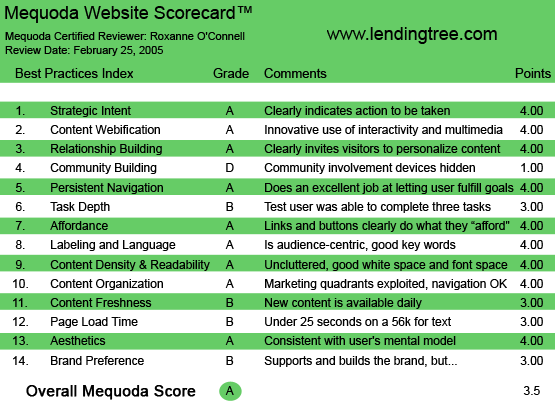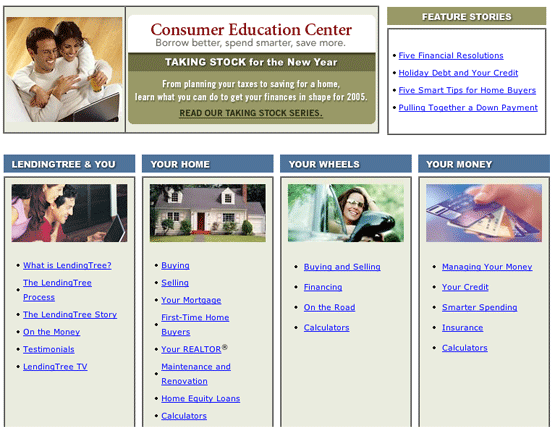There are two things in life that make us feel successful and powerful, or weak and ineffectual: sex and money. Today, we’re talking about money.
The very thought of going to a bank for a loan has often been enough to make us feel small and powerless. It is asking for help. It requires disclosing intimate, personal information—stuff you won’t tell your mother—about how you spend your money and pay your bills.
Historically, unless you were looking for a business loan, it was an admission of inadequacy and the loan officer had the power of life or death over your financial aspirations. Things improved somewhat after deregulation, but you still had to look the loan officer in the eye and say, “I need to borrow some money.”
Well, Hallelujah! Now there’s the Web and LendingTree.com! Fill out one simple form and get lots of bankers to beg for the pleasure of your business… and you don’t even need to see one of them face-to-face. This has GOT to be a recipe for success—but only if their website lives up to the promise of being easy to use, secure and successful at making you the top dog in this transaction.

LendingTree.com’s Mequoda Scorecard
[text_ad]
1. Strategic Intent – A
LendingTree’s strategic intent is very clear. It’s spelled out in the middle top of the page where everyone can see: “Fill out one simple form and get BANKS and REALTORS competing for your business.” However, ever since ChoicePoint, an information aggregator of personal data, announced that its vetting processes had been compromised and thousands of consumer records had been made available to criminals posing as legitimate companies, the issue of using the Web to collect or post personal information has become a sensitive one. LendingTree addresses the issue right up front, providing links on every page and at every decision juncture to make sure the user is aware the reasons why LendingTree collects this information and how your personal information will be used:
- Your Privacy is Important to Us. At LendingTree, your privacy is our chief concern. We understand that you entrust us with your private financial information to help us match you with a bank, lender or loan broker (we refer to all of these as “Lenders”) or real estate professional who can meet your needs. In exchange for your trust, you expect and deserve our commitment to treat your information with respect. Rest assured that we protect your privacy. Under no circumstances will LendingTree sell or share any personal information about you to or with any person or organization except: as authorized by you, to participating lenders, real estate professionals or other parties involved in your transaction, or as may be required by law or court order. The Privacy Policy below describes the standards we adhere to in handling information about you and your loan request.
They also provide a Lender’s Scorecard which provides background information on certain affiliate lenders and their loan officers. Websites that need to collect this level of personal data should follow LendingTree’s lead and spell everything out. With identity theft rapidly becoming the next big crime wave, sites that aren’t open and clear about their policies will not be able to gain users’ trust.
2. Content Webification – A
Let’s face it—no one likes to fill out forms. And with the exception of getting your kids into college, no other activity generates as many forms as trying to borrow money. (No, wait—it’s getting the money for college that generates most of the college forms, so it’s still all about money.) At least filling out forms online is less tedious than doing it on paper. And if you allow a site to securely store your information, you can spend even less time filling in the same data. But LendingTree goes one step further—you don’t even fill out a form—you answer some simple questions. LendingTree uses the type of wizard interface, first pioneered by MacInTax and TurboTax, that asks you questions in plain English. By the time you have answered the questions, all the information that was needed to proceed is captured and you move on to seeing the results.

LendingTree goes one step further—you don’t even fill out a form—you answer some simple questions.
They uses the type of wizard interface, first pioneered by MacInTax and TurboTax,
that asks you questions in plain English.
3. Relationship Building – A
Considering how much personal information is required for a loan application, this site handles the collection, and then the presentation, of personal data very well. They also do a very nice job handling errors. But more about that later. I went in and out of the site several times. It was readily apparent when I was logged into the site as my name was prominently displayed in the top right quadrant. The view presented once you log in is a status update on all your loan inquiries… so it’s all about you—very personal.
4. Community Building – D
The common use of the term community really doesn’t apply to this kind of site. However, since the purpose of the site is to bring borrowers and lenders together, I felt we could measure that. I give them a “D” based on recent events and how they are manifest in my test experience. LendingTree first positioned itself as a clearinghouse… you fill out one form and lots of candidates for your loan contact you. However, they have recently purchased their own bank so that LendingTree has set itself up as potential competition for its affiliates. This can generate some confusion and not a little doubt in the mind of the consumer. So much so that LendingTree writes, in all caps, bolded, that:
- You are NOT required to use LTL as a condition for the purchase of your home or obtaining any other settlement services from LendingTree, Inc. THERE ARE OTHER LENDERS AND MORTGAGE BROKERS AVAILABLE WITH SIMILAR SERVICES. YOU ARE FREE TO SHOP AROUND TO DETERMINE THAT YOU ARE RECEIVING THE BEST SERVICES AND THE BEST RATE FOR THESE SERVICES.
However the first three or four lenders you hear from come through their wholly owned subsidiary, Lending Tree Loans. What seems to actually happen is that three offers get posted from lenders that aren’t even on their site’s lender list—offers which you probably won’t accept. In my case it was rates on a home equity loan that seem to have favorable intro rates but follow-on rates that were twice what I would get at my neighborhood bank, considering my FICO score.
Almost immediately, you get an email from a loan officer suggesting that there are much better offers out there but they will need some additional information in order to get those offers. They seem to be acting very much like brokers and not like a clearinghouse of offers, which the loan seeker then pursues. And this brings me to my point. If they are supposed to bring borrowers and lenders together, why is it that the only lender I get to talk to is LendingTree?

If LendingTree is supposed to bring borrowers and lenders together, why is it that
the only lender I get to talk to is LendingTree?
There seems to be some misdirecting going on here. And while we are in the business of evaluating the interface, we have to refer to the underlying business model to see if there is perceived consistency. And, in this case, the mission copy doesn’t seem to be consistent with the site’s, or the organization’s, behavior.
5. Persistent Navigation – A
Nothing works like success. This site uses the tab metaphor for its graphic navigation, 3-D buttons for executing tasks, and blue, underlined text for links—all textbook methods for navigating through a site. So many sites try to reinvent the wheel and devise clever navigation strategies and metaphors overlooking the simple fact that navigation is merely a means to an end. Give users something they can relate to and you have an easy to use, intuitive interface. The tab metaphor, text links and buttons work well because people know how tabs, links and buttons work.

Give users something they can relate to and you have an easy to use, intuitive interface.
6. Task Depth – B
I looked at four tasks:
- Browsing for what kinds of loans I can get
- Searching using the search function for “bridging loan” and “building loan”
- Applying for a loan
- Researching the privacy policies and terms and conditions.
You can spend a lot of time on this site but getting a loan has never been an easy thing. Having just bought a house last year, I can tell you the hours I spent on the Internet and phone looking for a bank and mortgage made this process look easy. Browsing for loans and information was easy and intuitive. Applying for a loan, getting help and researching privacy information was also user friendly. However, their search engine was a disappointment. It didn’t yield anything for my search terms—common enough terms if you are looking to build an addition onto your house. As is often the case, the search engine was most likely built to index the words on the site and other possible terms have not been added and linked to associated content. LendingTree should go through its search logs and find terms that users may have used and intelligently redirect them to appropriate content. Sometimes, it takes a human being to put two and two together.

Their search engine was a disappointment.
It didn’t yield anything for my search terms—common enough terms if you are looking
to build an addition onto your house.
7. Affordance – A
I have to say, we rarely find sites that are so conscientious about links and buttons. My only critique on their buttons is that they use the color red. In western culture we have been conditioned to associate the color red with “STOP” or “danger,” so it surprises me to see it used in cases where site publishers clearly want users to proceed. They should take a page from Amazon on this one and use an orange/yellow button for two reasons:
- they avoid the “stop/danger” impulse, and
- they benefit from the fact that human notice the color yellow before any other color.

My only critique on their buttons is that they use the color red.
8. Labeling and Language – A
The only problem I had was determining what kind of loan was appropriate for building onto our house. I had always heard it referred to as a building or bridging loan. This is where the keyword search could be improved.
I was especially impressed with the way they handled error messages—a perennial problem area for most sites, as it is usually the engineers that write the error messages and not the copywriters. LendingTree does an admirable job of putting the error message close to the problem, in the user’s language, while providing a suggestion for correcting the problem. This is textbook handling of errors so that the user doesn’t get frustrated or feel “wrong.”

LendingTree does an admirable job of putting the error message close to the problem,
in the user’s language, while providing a suggestion for correcting the problem.
Everything else was in user-friendly language and well labeled. Considering that banks have historically used the most arcane language for lending money, this was a refreshing change. And if you were still a little confused, every question or term that might be confusing had a “Click for Tip” link that popped up a window that explained just what was expected or how to improve your chances of getting approved for the loan. 
9. Content Density and Readability – A
LendingTree’s website has excellent readability, both in the use of white space and the choices of fonts and font sizes for both body copy and headings. Fonts are scalable using the browser’s “Make Bigger/Smaller” function. Their designers could improve this functionality (and get bonus points) by putting font-scaling icons on the page.
10. Content Organization – A
This website is very well organized. Users have universal access to all areas of the site except when they are in the process of filling out an application—absolutely appropriate to the task. There is an extensive education center with information on loans, house buying and selling, caring for your home, your car and your money—tons of helpful information.

LendingTree is very well organized, with an extensive education center.
11. Content Freshness – B
There’s nothing really to rate the freshness until you actually fill in the forms. At that point, your own information refreshes the content. They could provide real-time mortgage rate information or news on their homepage. But one must ask—unless someone is actually looking for a loan, does LendingTree really want you as a repeat visitor? Unlikely. There’s nothing to consume here on a regular basis, and that’s probably OK.
12. Load Time – B
While the site isn’t slow, it isn’t fast either. It took less than 25 seconds to load using a 56k modem (using the Web Page Analyzer), so load time could be improved.
13. Aesthetics – A
With the exception of the red buttons, which, as we’ve mentioned, seem to send a contradictory subliminal message, we found the aesthetics of the site to be excellent. The imagery and navigation fit the mental model of a reliable, secure, trustworthy financial services website.
14. Brand Preference – B
LendingTree, Inc. started with an innovative service—one that only the power of the Internet could make possible. Like eBay and Google, they promised to unleash the resources of the Web onto your desktop by bringing your single loan application to thousands, if not millions, of lenders and allowing them to compete for your business. They may be tarnishing the brand by involving a wholly owned subsidiary, Lending Tree Loans, as a preferred lender—in essence playing the role of gatekeeper instead of clearinghouse. It remains to be seen if this strategy is one that the consumer understands and is willing to accept.
Conclusion
As the leading example of a Mequoda™ Lead Generation Website, and the first Mequoda review to score an A, LendingTree.com is clearly a leader in its industry. The site’s asthetics, readability, webification and intent are right on point. While their brand is still strong, I am interested in seeing how consumers will respond to their role as gatekeeper. It’ll be interesting to review this site in another year or so to observe if they’ve made any changes to their strategy.
[text_ad]



I have read so many posts about the blogger lovers except this piece of writing is actually a nice piece of writing, keep it up.